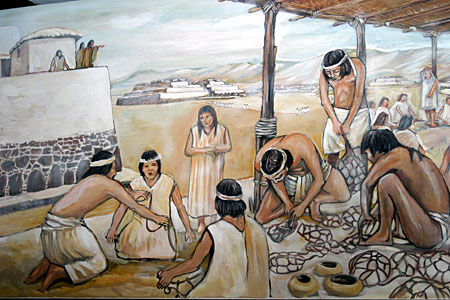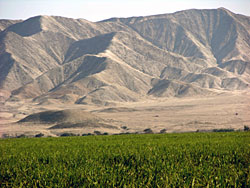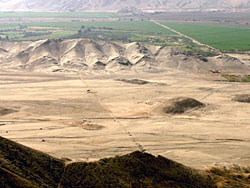
| Mural by Jose Salazar of Peru depicting the ancient Peruvians using shicra net bags filled with rock for pyramid construction at Caballete in the Fortaleza Valley of Norte Chico. |
By Joel Skidmore
Posted January 1, 2005
|
In April of 2001, Mesoweb reported on the South American site of Caral, which had been radiocarbon dated to 2627 B.C. Although far afield from Mesoweb's coverage area of Mesoamerica (ancient Mexico and adjacent Central America), the finding was significant for the New World in general, marking as it did the beginnings of advanced culture in the Americas. Now it emerges that Caral was but one of a cluster of sites comprising a major cultural complex going back as far as 3100 B.C.
The existence of more than twenty major centers of a socially stratified agricultural society with monumental architecture was reported in the current issue of the journal Nature by Dr. Jonathan Hass, an archaeologist at the Field Museum in Chicago, his wife Dr. Winifred Creamer of Northern Illinois University, and Alvaro Ruiz, a graduate student at Northrn Illinois. Labor was organized on a grand scale to create irrigation canals, massive pyramids, ceremonial plazas and extensive residential areas, according to the investigators. A map by Jill Seagard of the Field Museum shows 25 archaeological sites in addition to Caral arrayed in close proximity in the coastal valleys of the Norte Chico region of Peru, about 100 miles north of Lima. Ninety-five new radiocarbon dates from thirteen of the sites, added to thirty-two previously obtained, establish that the Norte Chico culture thrived for more than 1,200 years. "The cultural pattern that emerged in this small area in the third millenium B.C. later established a foundation for 4,000 years of cultural florescence in other parts of the Andes," Professor Haas stated in a Northern Illinois University press release. According to the press release:
The outline of one of the circular plazas can be seen in a photograph on the Proyecto Arqueólogo Norte Chico website. Such monumental construction 5,000 years ago predates the pyramids of Egypt, the first of which were built about 4,560 before present. According to the NIU press release:
Maize was first domesticated in Mesoamerica and became a staple grain crop there before spreadiing to North and South America (Benz 2001). The NIU press release is headlined "Archaeologists shed new light on Americas' earliest known civilization". Indeed, should this precocious South American culture be termed a civilization? "'By their works ye shall know them,' and archaeologists tend to judge cultures as civilizations by the presence of great public works and unified, evolved, monumental art styles" (Coe and Koontz 2002). By this standard the Norte Chico complex qualifies by virtue of its public works but not its art style. Not only are there no signs of monumental works in stone, but the Peruvian culture even lacked ceramics. "Some people would say they were not a civilization," Professor Creamer admitted to the BBC News. "They had very few arts and crafts for example - they were pre-ceramic. And if civilization needs urbanization - well, we don't know if these sites qualify as urban centers yet." According to the NIU press release:
The fruits of these further investigations will be of interest to all students of Precolumbian societies. For now, it has been well established that highly complex culture—perhaps even civilization itself—had its American beginnings on the Pacific littoral of Peru. |
home


